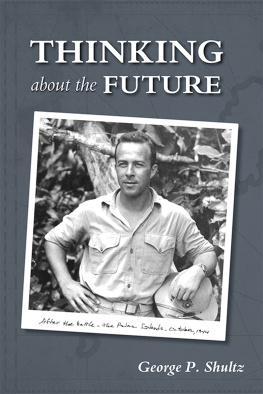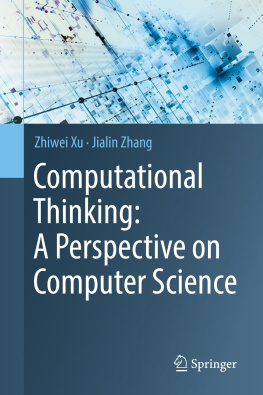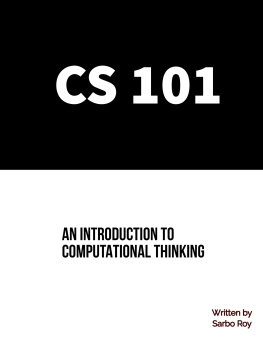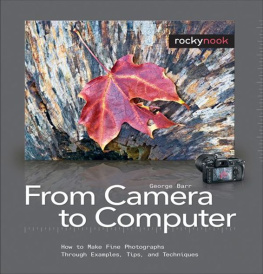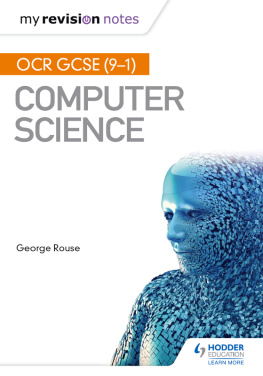Towner George - Thinking Like a Computer
Here you can read online Towner George - Thinking Like a Computer full text of the book (entire story) in english for free. Download pdf and epub, get meaning, cover and reviews about this ebook. year: 2020, publisher: Austin Macauley Publishers, genre: Religion. Description of the work, (preface) as well as reviews are available. Best literature library LitArk.com created for fans of good reading and offers a wide selection of genres:
Romance novel
Science fiction
Adventure
Detective
Science
History
Home and family
Prose
Art
Politics
Computer
Non-fiction
Religion
Business
Children
Humor
Choose a favorite category and find really read worthwhile books. Enjoy immersion in the world of imagination, feel the emotions of the characters or learn something new for yourself, make an fascinating discovery.

- Book:Thinking Like a Computer
- Author:
- Publisher:Austin Macauley Publishers
- Genre:
- Year:2020
- Rating:3 / 5
- Favourites:Add to favourites
- Your mark:
- 60
- 1
- 2
- 3
- 4
- 5
Thinking Like a Computer: summary, description and annotation
We offer to read an annotation, description, summary or preface (depends on what the author of the book "Thinking Like a Computer" wrote himself). If you haven't found the necessary information about the book — write in the comments, we will try to find it.
Thinking Like a Computer — read online for free the complete book (whole text) full work
Below is the text of the book, divided by pages. System saving the place of the last page read, allows you to conveniently read the book "Thinking Like a Computer" online for free, without having to search again every time where you left off. Put a bookmark, and you can go to the page where you finished reading at any time.
Font size:
Interval:
Bookmark:
An Introduction to Digital Reality
George Towner
Austin Macauley Publishers
2020-09-30
The author, George Towner, studied logic and philosophy at Berkeley, then became assistant director of the Kaiser Foundation Research Institute, working on the biology of primitive organisms. When the computer revolution reached Silicon Valley, he switched to information technology and served 30 years on the senior technical staff at Apple. In his independent research, Towner analyzed how computers evolved from early number crunchers into todays smart digital assistants. Thinking Like a Computer presents a compelling new explanation, based in set theory, of how both people and computers understand reality.
George Towner (2020)
All rights reserved. No part of this publication may be reproduced, distributed, or transmitted in any form or by any means, including photocopying, recording, or other electronic or mechanical methods, without the prior written permission of the publisher, except in the case of brief quotations embodied in critical reviews and certain other noncommercial uses permitted by copyright law. For permission requests, write to the publisher.
Any person who commits any unauthorized act in relation to this publication may be liable to criminal prosecution and civil claims for damages.
Austin Macauley is committed to publishing works of quality and integrity. In this spirit, we are proud to offer this book to our readers; however, the story, the experiences, and the words are the authors alone.
Ordering Information:
Quantity sales: special discounts are available on quantity purchases by corporations, associations, and others. For details, contact the publisher at the address below.
Publishers Cataloging-in-Publication data
Towner, George
Thinking Like a Computer
ISBN 9781645759270 (Paperback)
ISBN 9781645759263 (Hardback)
ISBN 9781645759287 (ePub e-book)
Library of Congress Control Number: 2020916187
www.austinmacauley.com/us
First Published (2020)
Austin Macauley Publishers LLC
40 Wall Street, 28th Floor
New York, NY 10005
USA
mail-usa@austinmacauley.com
+1 (646) 5125767
Discoveries made during the last fifty years suggest a new approach to understanding how knowledge supports life.
IF ANY OF MY GRANDCHILDREN grow up to be historians they will marvel at our present age. Beginning in the 1980s, the widespread availability of computing power upended many traditional skills. As a teenager, I learned the rudiments of printing, bookkeeping, and photography. Today, most of what I learned is obsolete. Printing migrated from hot metal to desktop publishing, bookkeeping from paper to spreadsheets, photography from film cameras to telephones. All this and now my car wants to drive itself.
To keep up with the times, I moved to Silicon Valley, learned programming, and joined the engineering staff at Apple. Pure luck gave me entree to the mosh pit that people began calling the digital revolution. During the next 30 years, I watched the revolution unfold and became aware that it affected more than just lifestyles and office work. At Berkeley, I had been trained in logic and philosophy, and afterward I had immersed myself in biology at the Kaiser Foundation Research Institute. At Apple, I was surrounded by rough-and-ready philosophers who were using logic to design machines that acted like living things. I was working with very bright guys who every day solved deeply theoretical problems of human knowledge that would have blown away the likes of Aristotle, Newton, and Kant.
Other Silicon Valley enterprises contributed to this effortSRI, Intel, PARC, NeXT, Google, Adobeand it began to dawn on me that I was in the midst of something like a philosophical laboratory at work. Imaginative people, trying to make machines think, were experimentally challenging the foundations of traditional science.
The upshot was that I gained a new understanding of how knowledge works at the nuts and bolts level. The idea was not that people are like computers. Rather, the idea was that computers were supposed to act like people. All those experiments with hardware and software, all those trials and errors, uncovered novel principles of human knowledge that made sense to me and that worked in machines.
My key discovery was digitization, a complex machine technology developed in the twentieth century. You and I and our computers interact with the world around us in analog ways, yet we are capable of thinking and acting in digital terms. Digitization is not just peculiar to us or to Homo sapiensit is baked into the nature of life itself. In fact, analog-to-digital conversion is one of lifes primary skills. From this insight, Digital Reality Theory was born. The basics of DR Theory can be expressed in seven words:
Life understands existence by constructing digital realities.
A hundred years ago most people would have found this seven-word summary incomprehensible, yet today it makes sense. It took three intellectual developments during the nineteenth and twentieth centuriesevolution, set theory, and digitizationto achieve that change and to make DR Theory possible:
During the second half of the nineteenth century, Darwins principle of evolution recast many ideas about life. Among them was the idea of fixed knowledge. How does the world work? was a question that tradition claimed had one answerif only we knew how to find it. Thinkers such as Newton and Kant had searched for the principles behind the development of knowledgeNewton picked mathematics and Kant picked reasoningbut it never occurred to them that life itself evolved and that knowledge changed naturally with it.
Set theory was invented in 1874. Mathematician Georg Cantor launched what is now called nave set theory by showing how to construct sets of numbers as real mathematical objects. In the 1920s two logicians, Ernst Zermelo and Abraham Fraenkel, worked out the general rules for constructing sets of elements of any kind and for verifying that the sets were real objects. This became the tightly logical discipline known as axiomatic set theory.
Digitization as an information technology originated in the twentieth century. While computers evolved from number crunchers to multimedia processors, their designers invented algorithms for converting analog data to digital form. The science of analog-to-digital conversion was born.
The latter two developments laid the foundation for todays smart computing devices. All such devices, from desktop computers to mobile telephones, are designed to construct sets of digital bits internally to represent external analog phenomena such as images, sounds, events, and even whole artificial realities. Smart devices do this for efficiencydigitization helps them sort out the essential from the trivial and adapt old solutions to new tasks. We and other living things digitize the world we live in for the same reasons. We construct digital realities inside to solve analog problems outside.
DR Theory emerged when the principles of evolution, axiomatic set theory, and the science of digitization were added to traditional theories of knowledge. Books published during the last forty years have presented enough detail about the theory to make its messages clear. The present book summarizes the latest state of DR Theory in six chapters:
Font size:
Interval:
Bookmark:
Similar books «Thinking Like a Computer»
Look at similar books to Thinking Like a Computer. We have selected literature similar in name and meaning in the hope of providing readers with more options to find new, interesting, not yet read works.
Discussion, reviews of the book Thinking Like a Computer and just readers' own opinions. Leave your comments, write what you think about the work, its meaning or the main characters. Specify what exactly you liked and what you didn't like, and why you think so.


